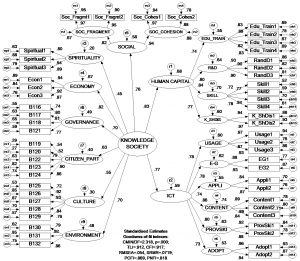SMART CITY: Integration of Smart Visual Surveillance, Waste Management and Health Wearable Device in Smart Neighbourhood [LRGS/TD/2011/UKM/ICT/04/01]
– Headed by Prof. Dato’ Dr. Halimah Badioze Zaman.
The Smart City/Smart Neighbourhood research was based on the design framework of the Integrated SmartCity/Smart Neighbourhood. The framework encompass dimensions that would drive technology, economic and social aspects of the smart city/smart neighbourhood, namely human factor dimension to meet the needs of a specific sector of the populace of the smart city or neighbourhood such as the elderly; and the envionment factor dimension to meet aspects on: health, cleanliness and security. Video
INTRODUCTION OF RESEARCH
As mentioned earlier, the Integrated Smart City/Smart Neighbourhood (ISC/SN) framework was based on dimensions related to human capital, based on a specific sector, the elderly; and the environment dimension the include elements such as security, cleanliness and health respectively. Figure 1 shows the human capital and environment dimensions as the most important dimensions in the ISC/SN Framework.
Figure 1: AMOS Output –2nd order factor
(Human capital and environment dimensions as most important of the ISC/SN Framework)
FINDINGS OF RESEARCH
Therefore, as findings of the analysis on a knowledge or digital society showed that the most important dimensions were the human capital and environment, which includes elements such as elements such as security, cleanliness and health. Thus, these elements were used to build the tools such as: the video surveillance visualisation system & JagaBOT™; intelligent waste monitoring system; & the wearable elderly electronic handling & emergency response application (W-Emas™) for a smart home in a secured and clean smart neighbourhood of a smart city. The intelligent patrol robot system for real time comprehensive surveillance of the smart home and offices of the smart city, would ensure safe and secure environment. The system, called the JagaBotTM comprises three main modules: (i) the physical JagaBotTM itself; (ii) the JagaBotTM operation and control system; and (iii) the server system. This system is innovatively unique as it can execute dynamic on-site inspection and mitigation action upon detection of an anomalous event. The intelligent waste monitoring system is based on the Wireless Sensor Networks (WSN) which is built on a three level architecture consisting of smart bin, gateway and control station. All the sensors are integrated on a sensor board which is connected to the Waspmote sensor platform. The Wearable Elderly Electronic Handling & Emergency Response Application (W-Emas™) for a smart home in the smart city/smart neighbourhood environment can help the elderly to lead a more secure and safe life in the new smart city/smart neighbourhood environment. The W-Emas™ can also help the elderly to call for emergency response from this wearable device to their children or friends when they fall ill suddenly.
FUTURE WORKS
The prototypes of this research shall be practically implemented in a real newly constructed smart home in a smart neighbourhood of a smart city. The institute is working with MIGHT and a company called Sistem Perintis to see possible collaboration work that can be conducted in newly designed smart neighbourhoods in smart cities such as Malacca, Putrajaya and Selangor.


